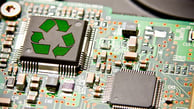- Services
- Industries
- Automotive
- Battery
- Building inspection
- Fire alarms system testing
- Household appliances
- Installation materials
- Industrial machinery
- IT & audio video
- Laboratory, test & measurement
- Lighting equipment
- Maritime, oil & gas
- Medical & healthcare equipment
- Military & aerospace product testing
- Wireless & telecom
- Resources
- About
- Blog
- Events


Waste of electrical and electronic equipment (E-Waste) has emerged as a serious issue for the whole world along with the evolution of modern industry. E-waste plastic contains heavy metals (arsenic, mercury, chromium, cadmium, lead, etc.) and halogen materials (bromine, chlorine, etc.), which are toxic and harmful to the environment. Therefore, the recycling of the plastic content is necessary and critical.
Not least is effective disposal of printed circuit board waste (WPCB) an environmental challenge, since it is environmentally hazardous, difficult to recycle, and contains valuable materials.
According to statistics, more than 50 million tons of e-waste are accumulated in the world every year, and up to 10% of this mass is WPCB. PCBs traditionally used in the electronics industry consist of a composite, dielectric base that acts as a rigid, mechanical frame. Electrically conductive tracks are made by etching copper foil formed on one or both sides of the dielectric base. The dielectric base consists of several layers of glass fabric or paper impregnated with thermosetting resin as a binder and then formed in a hot press. Currently, the raw materials used for binders are highly toxic and derived from non-renewable sources.
WPCB consisting of a metallic (abt.30 wt%) and a non-metallic fraction (abt.70 wt%) is difficult to recycle.
Today, WPCB recycling is mainly aimed at recovering the high-value-added metals, while the non-metallic fraction is usually landfilled or incinerated without further recycling. The non-metallic WPCB fraction contains toxic resins and brominated flame retardants, which are extremely hazardous compounds affecting human health and causing cancer.
The above threats have prompted an active scientific search for WPCB disposal and recycling methods. A result is a composite binder material for printed circuit boards (PCB) that can be easily recycled into their original components and reused. In addition, the most valuable PCB components (electronic components containing precious metals) can be easily separated and reused.
The composite material concerned is biodegradable polymers. It is expected that gradual switching to such renewable raw materials in the production of commercial PCBs and implementing processes for their easy recycling, can positively impact the conservation of valuable, non-renewable resources. Thus, the possibility of their reuse can bring the PCB manufacturing industry much closer to adopting a circular economy.
Learn more about the environmental impact of E-waste, challenges in recycling printed circuit boards (WPCB), and innovative solutions for sustainable PCB manufacturing.
(The article is based on the article published on nature.com and edited by T.Sollie)

